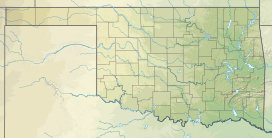Turkey Mountain (Oklahoma)
| Turkey Mountain | |
|---|---|
 | |
| Highest point | |
| Elevation | 919 ft (280 m) |
| Coordinates | 36°04′23″N 95°59′41″W / 36.0731497°N 95.9947184°W |
| Geography | |
Size and location
Turkey Mountain is a hill occupying a wide area on the west side of the Arkansas River in Tulsa, Oklahoma. The summit is 300 feet (91 m) above the river below, offering a view of Tulsa. The park stretches between Interstate 44 to 71st Street, and US-75 to the Arkansas River.
The park started in 1978 with 147 acres purchased with Tulsa County, federal, and private funds. By 2023, the park had expanded to about 650 acres. In that year, about 88 additional acres were added, 73 of which were purchased by River Parks with sales tax funding, and 15 coming from private donation. The additional 88 acres are located across a street called Elwood from the core area of the park, and private donation is being utilized to create a safe path to link the properties.
Trails
The Turkey Mountain Urban Wilderness Area have four marked trails between 0.8 and 5.7 miles (1 and 9 km) in length, for running or cycling as well as over 25 miles (40 km) of unmarked trails. The 25 mile long River Parks paved trail passes through the Turkey Mountain Wilderness Area, close to the river, connecting the area to other river side parks in Tulsa.
In June 2016, the National Park Service designated the Turkey Mountain trails as part of the National Recreation Trail system.
The Turkey Mountain Master Plan calls for 40 miles of multiuse trails, of which more than 21 had been completed by October 2023. In addition, a project is underway to link Turkey Mountain with Bales and Lubell parks, which have an additional 9 miles of multiuse trails between them.
Additional Improvements
A 20,000 square foot park maintenance facility is being constructed on land adjacent to Turkey Mountain, on the north side of 71st St. and east of Elwood. Plans call for a new Visitors Center east of Turkey Mountain's lower parking lot off Elwood, and additional parking.
Claimed petroglyphs
Close to the river there are several markings in the stone, one of which has been claimed to be the letters "gwn" (claimed to mean fair or white hair). These were believed by writer Barry Fell to be petroglyphs left by pre-Columbian European travelers. The idea of Pre-Columbian trans-oceanic contact by Europeans, apart from the Vikings in Newfoundland, is considered a fringe theory or pseudoarchaeology. The park itself says the sandstone involved is very soft and vulnerable to erosion which would cause any markings to quickly fade, so at most the carvings were done in the 1920s by oil field workers who were scouring the area for oil.
References
- ^ "About Turkey MTN". River Parks Authority. Retrieved 2012-08-19.
- ^ USGS Geographic Names Information System (GNIS). Turkey Mountain. Accessed 22 May 2008
- ^ Elaine Warner (2009). Insiders' Guide to Tulsa. Globe Pequot. p. 3. ISBN 9780762763214. Retrieved 2012-08-19.
- ^ "Turkey Mountain wilderness area to add nearly 90 acres; $2 million grant will fund trails, amenities". Kevin Canfield, Tulsa World, October 5, 2023. Retrieved October 6, 2023.
- ^ "Turkey Mountain Urban Wilderness Area". RiverParks Authority. Retrieved October 6, 2023.
- ^ "River Parks announces plan to build visitors center at Turkey Mountain". Kevin Canfield, Tulsa World, October 2, 2023. Retrieved October 6, 2023.
- ^ "Turkey Mountain expansion planned with $2 million donation". Kevin Canfield, Tulsa World, October 5, 2023. Retrieved October 6, 2023.
- ^ "Turkey Mountain urban wilderness area map". River Parks Authority. Retrieved 2012-08-19.
- ^ "Tulsa’s Turkey Mountain Added To National Park Service's Trails System", KOTV, June 3, 2016.
- ^ "More land, trails coming to River Parks". Kevin Canfield, Tulsa World, May 28, 2023. Retrieved October 6, 2023.
- ^ "River Parks officials explain need for new maintenance facility". Kevin Canfield, Tulsa World, August 14, 2023.
- ^ Fell, Barry (1984) America B.C.: Ancient Settlers in the New World, New York, Simon & Schuster, p.49
- ^ Williams, Stephen (1991) Fantastic Archaeology, Phila., University of Pennsylvania Press, ISBN 0-8122-8238-8, pp. 264-273
- ^ Feder, Kenneth L. (1996) Frauds, Myths, and Mysteries: Science and Pseudoscience in Archaeology, Mountain View, Mayfield Publishing Co., ISBN 1-55934-523-3, pp. 101-107
- ^ Susan Jakobsen, "Mystery Mountain", Tulsa World, February 2, 2000.
- ^ Debbie Jackson and Hillary Pittman, " Fascination with Turkey Mountain is legendary", Tulsa World, March 12, 2015.
